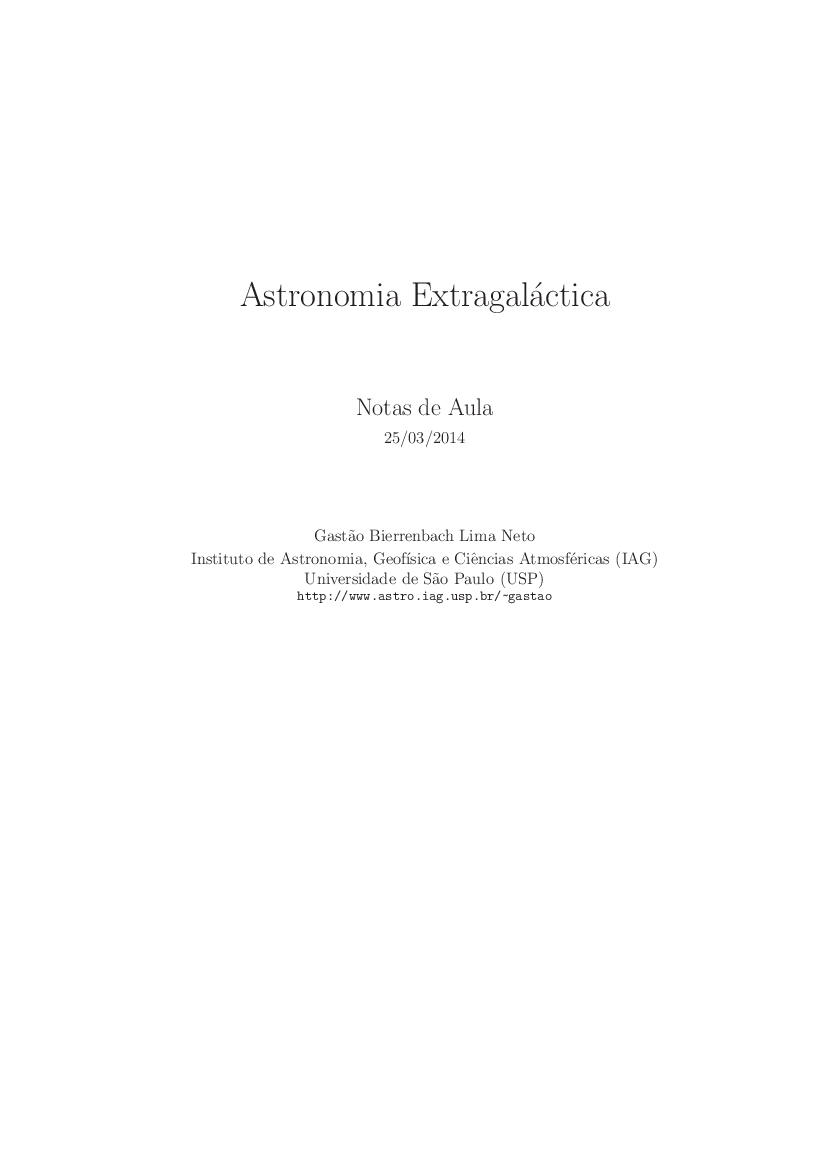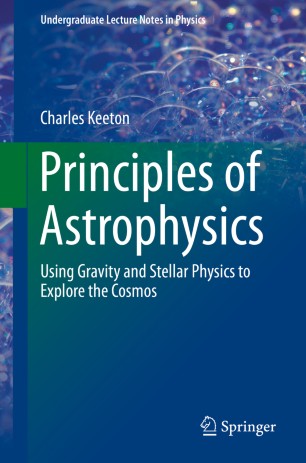Astronomia Extragalática e Cosmologia (Notas de Aula)

Clique aqui para acessar o livro.
Sumário
1 Breve Introdução Histórica
2 Introdução à cosmologia
2.1 Princípios básicos
2.2 Princípio antrópico
2.3 Expansão do Universo
2.3.1 Paradoxo de Olbers
2.4 História térmica do Universo primordial
2.4.1 Partículas relativísticas no Universo primordial
2.5 Radiação cosmológica de fundo em microondas (RCF ou CMB)
2.5.1 Dipolo cinemático e anisotropias da RCF (CMB)
2.5.2 Equipartição
2.5.3 Recombinação
2.5.4 Temperatura da matéria bariônica intergalática
2.5.5 Entropia da CMB
2.6 Radiação de fundo não cosmológica
2.7 Descrição geométrica do Universo
2.7.1 Redshift
2.7.2 Distâncias
2.7.3 Correção K
2.7.4 Contagem de objetos extragaláticos
2.8 Modelos de Friedmann-Lemaître
2.9 Parâmetros cosmológicos H0, ΩM , ΩΛ
2.9.1 Idade do Universo
2.9.2 Velocidade de recessão e redshift
2.9.3 Horizonte
2.10 Determinação observacional dos parâmetros cosmológicos
2.11 Inflação
2.12 Bariogênese
2.13 Nucleossíntese primordial
2.13.1 Balanço de bárions
2.14 Anisotropias da CMB
2.14.1 Efeito Sachs-Wolfe Integrado
2.14.2 Polarização da CMB
2.15 Antes do Big Bang
3 Formação de estruturas
3.1 Instabilidade de Jeans
3.1.1 Crescimento de perturbações
3.1.2 Crescimento de perturbações: Universo em expansão
3.1.3 Crescimento de perturbações maiores que o horizonte
3.1.4 Evolução das massas de Jeans e Silk
3.1.5 Velocidades peculiares
3.2 Flutuações primordiais
3.2.1 Matéria escura: quente e fria
3.2.2 Origem das flutuações primordiais
3.3 Tipos de Flutuações
3.4 Espectro de potência de flutuações
3.4.1 Evolução do espectro de potência P(k)
3.4.2 Normalização do espectro de potência
3.4.3 Modelo de “panqueca” de Zel’dovich
3.4.4 Modelo hierárquico
3.4.5 Halos de matéria escura
3.4.6 Matéria escura fria na vizinhança solar
3.5 Oscilações acústicas de bárions (BAO)
3.6 Simulações numéricas
4 Cosmografia, “surveys” e distribuição de galáxias
4.1 Distribuição de galáxias
4.2 Super-aglomerado de galáxias
4.3 Surveys 3D – redshift como distância
4.4 Função de correlação
4.4.1 Função de correlação e espectro de potência
4.4.2 Função de correlação em duas dimensões
4.4.3 Teste de Alcock-Paczynski
4.5 Determinação de distâncias sem redshift
4.5.1 Método de Opik (1922)
4.6 Campo de velocidades peculiares – Distribuição de massa no Universo próximo
4.7 Viés de Malmquist e efeitos de seleção
5 Aglomerados de galáxias
5.1 Histórico
5.2 Formação de aglomerados ricos (cenário hierárquico)
5.3 Catálogos
5.4 Classificação
5.5 Composição (matéria escura + galáxias + plasma)
5.6 Distribuição espacial das galáxias e sub-estruturas
5.7 Gás intra-aglomerado
5.7.1 Observação em raios-X
5.7.2 Observação em rádio – efeito Sunyaev-Zel’dovich
5.8 Determinação de massa
5.8.1 Galáxias e a “massa faltante”
5.8.2 Dinâmica – Teorema do Virial
5.8.3 Medida de redshift e velocidades
5.8.4 Equilíbrio hidrodinâmico: gás emissor de raios-X
5.8.5 Lentes gravitacionais
5.8.6 Comparação entre os indicadores de massa de aglomerados
5.9 Cooling-flow/ cool-core
5.10 Fração de bárions em aglomerados e a densidade do Universo
5.11 Efeitos do Aglomerado nas galáxias e vice-versa
5.11.1 Galáxias cD
5.11.2 Luminosidade difusa intra-aglomerado
5.11.3 Segregação mosfológica
5.11.4 Sequência vermelha e efeito Butcher-Oemler
5.11.5 Perda de gás por pressão de arraste
5.11.6 Assédio (Harassment) galáctico
5.11.7 Decréscimo da taxa de formação estelar
5.11.8 Curva de rotação de espirais em aglomerados
5.11.9 Metalicidade do gás intra-aglomerado
5.12 Emissão rádio extensa e campo magnético
5.13 Relações de escala (LX, TX, σ, YX)
5.14 Colisão de aglomerados
6 Aglomerados pobres e grupos de galáxias
6.1 Grupos compactos de galáxias
6.1.1 Catálogos
6.1.2 Objetos reais ou efeitos de projeção?
6.1.3 Emissão em raios-X
6.1.4 Interação entre galáxias
6.1.5 Instabilidade em relação à fusão
7 Grupo Local
7.1 Massa e raio do Grupo Local
7.2 Membros e vizinhos do Grupo Local
7.3 Galáxias dominantes
7.4 Galáxias anãs
7.5 Galáxias ausentes
7.6 Distribuição e dinâmica
7.7 Magellanic Stream (Corrente de Magalhães)
7.8 Distribuição planar das galáxias satélites
7.9 Movimento em direção a Virgo
8 Formação de galáxias no modelo hierárquico
8.1 Modelo Top-Hat
8.2 Virialização
8.3 Resfriamento do gás
8.4 Função de Press-Schechter – função de massa
8.5 Momento angular de galáxias
8.6 Colapso monolítico X modelo hierárquico
9 Função de luminosidade
9.1 Definição da Função de Luminosidade
9.2 Determinação da FL
9.2.1 Métodos não paramétricos
9.2.2 Descrições paramétricas da função de luminosidade
9.2.3 Estimativas da função de luminosidade
9.3 Origem da função de luminosidade
10 Evolução de galáxias
10.1 Evolução dinâmica
10.1.1 Relaxação de 2-corpos
10.1.2 Relaxação violenta
10.1.3 Fricção dinâmica
10.1.4 Efeito de maré
10.1.5 Fusões de galáxias (“mergers”)
10.2 Síntese evolutiva da população estelar
10.2.1 Classificação de populações estelares
10.2.2 Evolução da população estelar
10.2.3 Função de massa Inicial (IMF)
10.2.4 Taxa de Formação Estelar (SFR)
10.2.5 Evolução química
10.5.6 Idade X Metalicidade
10.3 Observações a alto redshift
10.3.1 Redshift fotométrico
10.3.2 Galáxias em alto redshift
10.4 Poeira
11 Núcleos ativos
11.1 Seyfert
11.2 LINERs
11.2.1 Objetos de transição
11.3 BL Lac – Blazar
11.4 Markarian
11.5 Radiação síncrotron
11.6 Rádio galáxias
11.6.1 Morfologia da emissão
11.6.2 Jato superluminar
11.7 Quasares, QAOa
11.7.1 Evolução de QSOs
11.8 Floresta Lyα
11.8.1 Sistemas Lyman-α saturados (DLA)
11.9 Variação Temporal
11.10 Modelo unificado e “zoologia” de núcleos ativos
11.10.1 “Motor central”
11.10.2 O motor central pára – BN supermaciços em galáxias “normais”
12 Reionização do Universo
12.1 Fim da ‘Idade das Trevas”
12.2 Esfera de Stromgren
13 Galáxias com surto de formação estelar : “Starburst”
14 Galáxias normais
14.1 Classificação morfológica
14.1.1 Classificação de Hubble
14.1.2 Classificação de Vaucouleurs e outros
14.2 Tipos morfológicos: características
14.2.1 Galáxias anãs e de baixo brilho superficial
14.2.2 Morfologia: dependência com a banda de observação
14.3 Classificação espectral
14.4 Bimodalidade das galáxias
A Supernovas
A.1 Classificação
A.1.1 Taxas
A.2 Hipernovas
A.3 Kilonovas
B Partículas elementares e forças
C Transparência da atmosfera
D Constantes úteis para luminosidade e magnitude
Autor: Gastão Bierrenbach Lima Neto













